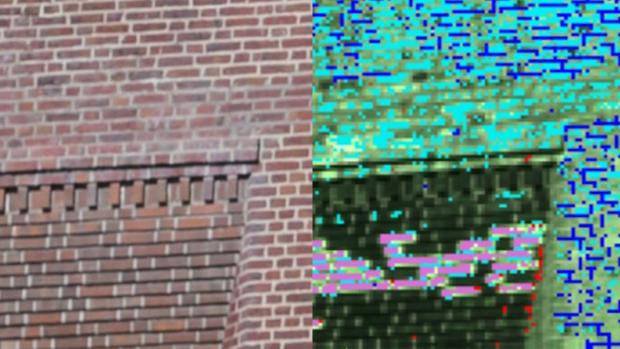Professor Debra Laefer Discovers a New Way to Analyze Building Strengths and Weaknesses

A photograph of a brick wall on the left appears fairly uniform in composition, however, the hyperspectral image on the right reveals there is a section of very different bricks, possibly due to a repair or a different source of bricks in the initial construction.
Hyperspectral imaging can help researchers studying the built environment distinguish between materials like stone and concrete that is colored and finished to look like stone without the need to be directly on-site. Professor of Civil and Urban Engineering Debra Laefer, who is also affiliated with NYU’s Center for Urban Science and Progress (CUSP), recently collaborated with colleagues in Ireland to prove that this same technology can also identify different samples within a single type of material, such as concrete with a higher-than-recommended water content.
It thus becomes possible to identify weak materials in the building’s façade or piece of infrastructure without touching it — an important innovation given that most traditional materials-testing procedures require actually destroying samples.
The research is of great practical use to a wide variety of stakeholders, including building owners, developers, and preservationists, who may now have a new technique to quickly investigate the integrity of in-place construction materials and use that data to inform their respective activities.
Additionally, because hyperspectral imaging can be done from the air or from autonomous vehicles on a city-wide scale, public agencies may be able to conduct initial district-level inspections more rapidly and cost-effectively, all without erecting scaffolding or otherwise inconveniencing pedestrians. This can contribute significantly toward making a more efficiently run, livable urban environment.
Laefer’s conclusions were widely covered by the press, and the consensus is that she has pointed the way for an important new tool for infrastructure management and architectural preservation.
“Tandon’s civil and urban engineers have a long history of making practical contributions to life in our city,” said Department Chair Magued Iskander. “I am proud to see Debra Laefer continuing that tradition with her latest important research.”
What Is Hyperspectral Imaging?
A regular color camera acquires an image by recording the scene in three colors: red, green and blue. These colors correspond to the color sensitivities of the cone cells (the basic units through which humans have color vision). Despite having only three primary colors, we perceive a rich, multi-colored scene through color mixing. That is, through different combinations of red, green and blue, we are able to perceive many thousands of shades of colors ranging from bright reds, oranges, and yellows to deep violet. A scene captured this way may be visually compelling, but contains very little information about the light intensity at specific wavelengths.
Hyperspectral images, on the other hand, are produced by sensors called imaging spectrometers. These instruments typically use a diffraction grating to spread incoming light out into its spectral components (analogous to how a prism breaks up a beam of white light into a rainbow). Through careful alignment and a scanning mechanism, a hyperspectral sensor records the light intensity for up to several hundred individual spectral bands for every pixel in an image (as opposed to three broad colors in a regular color camera). As a result, each individual pixel in a hyperspectral image contains behind it a continuous spectrum that can be used to characterize objects with unprecedented precision and minute detail. These spectra include within them a vast amount of information including absorption and emission lines identifying compounds in the atmosphere. Components and characteristics of surfaces in the field of view can be distinguished through reflection spectra, and scattering profiles can identify particulate matter in the air. The technology has proven to have widespread application in a broad range of fields, from national security (in target detection, for example) to biomedicine (for disease diagnosis, among other uses).




